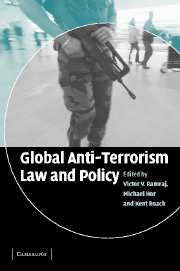Book contents
- Frontmatter
- Contents
- List of contributors
- Acknowledgements
- 1 Introduction
- PART ONE Theoretical Perspectives on Anti-Terrorism Law and Policy
- PART TWO A Comparative Study of Anti-Terrorism Measures
- PART THREE Anti-Terrorism Law and Policy in Asia
- PART FOUR Regional Cooperation
- PART FIVE Anti-Terrorism Law and Policy in the West
- 21 Legislative over-breadth, democratic failure and the judicial response: fundamental rights and the UK's anti-terrorist legal policy
- 22 United States responses to September 11
- 23 Canada's response to terrorism
- 24 The rule of law and the regulation of terrorism in Australia and New Zealand
- PART SIX Anti-Terrorism Measures in Africa, the Middle East and Argentina
- Index
22 - United States responses to September 11
Published online by Cambridge University Press: 21 July 2009
- Frontmatter
- Contents
- List of contributors
- Acknowledgements
- 1 Introduction
- PART ONE Theoretical Perspectives on Anti-Terrorism Law and Policy
- PART TWO A Comparative Study of Anti-Terrorism Measures
- PART THREE Anti-Terrorism Law and Policy in Asia
- PART FOUR Regional Cooperation
- PART FIVE Anti-Terrorism Law and Policy in the West
- 21 Legislative over-breadth, democratic failure and the judicial response: fundamental rights and the UK's anti-terrorist legal policy
- 22 United States responses to September 11
- 23 Canada's response to terrorism
- 24 The rule of law and the regulation of terrorism in Australia and New Zealand
- PART SIX Anti-Terrorism Measures in Africa, the Middle East and Argentina
- Index
Summary
The violent destruction of life and property incident to war, the continual effort and alarm attendant on a state of continual danger, will compel nations the most attached to liberty to resort for repose and security to institutions which have a tendency to destroy their civil and political rights. To be more safe, they at length become willing to run the risk of being less free.
The September 11 attacks profoundly affected the United States. Apart from the destruction of so many lives and the damage done to two of our most symbolically important buildings, the visual images of the attacks inflicted a level of trauma unknown to many Americans. The collective sense of fear and dread created by September 11, along with an understandable and palpable collective determination to rise up and ‘do something’ about terrorism, precipitated changes in laws and policies designed to counter the terrorist threat.
Acknowledging the risks of making judgments about the longer term from a perspective of three years from the event, the law and policy changes that are still being made by the United States may be part of what many inside and outside government now refer to as the ‘new normal’. In short, a longer term permanent realignment of the relative importance of security among our government's objectives may be taking place, perhaps at the expense of a thoughtful examination of terrorism and its antidotes.
- Type
- Chapter
- Information
- Global Anti-Terrorism Law and Policy , pp. 490 - 510Publisher: Cambridge University PressPrint publication year: 2005
- 4
- Cited by



